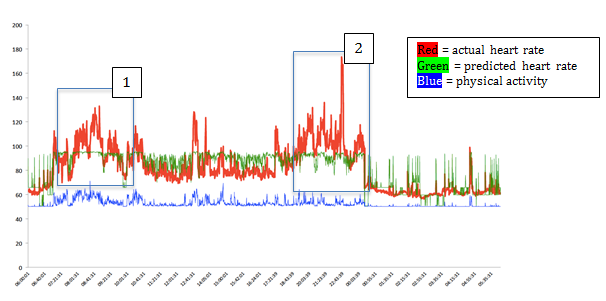Assessing stress: a matter of the heart?
'I didn’t see it coming until it was too late' – a remark I often hear from clients suffering from burnout. They had often been pushing the limits without realizing that their stress levels were building up.
This poses an important issue for stress researchers: if people are not always aware of their feelings of stress, then we can’t rely solely on questionnaires. Such questionnaires are only meaningful if people have some insight into their stress levels (‘how stressed do you feel?’). Are there alternative ways to measure the presence of ‘stress’ and to study its relation with health problems? Maybe we should try to measure stress in a more indirect manner, to measure ‘unconscious stress’ (a method my colleague Melanie van der Ploeg has previously blogged about and which is still under close examination).
Heart activity
Yet another interesting development is underway in the assessment of stress: measuring stress levels via the activity of the heart. It has long been known that our heart starts to beat faster when we face a threat. In the past few years several companies have come up with easy-to-use devices to measure the heart rate signal, for example via a smartphone, to inform people about their stress levels.
Physical activity
However, our heart rate also increases when we are exercising. Physical activity is one of the major determinants of changes in heart rate. Thus, when using heart rate to measure if people are stressed, we need to be sure that increases in heart rate are not due to physical activity (since telling people they are stressed when in fact they are simply exercising would increase rather than solve stress-related problems). Both researchers and the manufacturers of such devices largely ignore this issue. However, already in the 1970s a small group of researchers explored the possibilities to distinguish between heart rate increases that are due to physical activity (termed ‘metabolic heart rate’) and increases that are due to psychological stress (termed ‘excessive’ or ‘additional heart rate’). We are currently building on the work of these researchers to develop a more advanced method to measure stress using the heart rate signal.
Heart rate variability
We decided to focus on developing a stress-detection method that uses the variability of the heart rate signal instead of merely the heart rate itself. The heart does not work like a metronome: in fact, a lot of variability in the heart rate signal is a good sign. A higher level of heart rate variability (HRV) means more physical and psychological flexibility. Higher HRV is also indicative of good health. HRV goes down during physical activity and during stressful events. Given that short periods where HRV is decreased (sudden surprise, brief irritations) are unlikely to have detrimental health consequences, we decided to measure periods in daily life where HRV was reduced for at least 7.5 minutes (and this reduction was not due to physical activity).
In a first study we asked 32 students to visit our lab and perform several physical exercises (cycling, walking up and down stairs, lying down). We measured their HRV and their physical activity using a strap they could wear around their chest. We used the data gathered in the lab to create 32 models (one for each person) that described how physical activity was related to HRV. For each person we were now able to predict how low their HRV level would be based upon their level of physical activity (e.g., no movement? then HRV should be about 40; running? then HRV should be 30).
Emotional awareness
After the session in the laboratory, we monitored the participants’ HRV and physical activity for 24 hours as they went about their daily lives. Additionally, we asked them to report on their levels of stress each hour using their smartphone. On the basis of the individual models, we screened the HRV signals for these 24 hours (focusing on the periods when participants were awake) and marked periods where, for 7.5 minutes or longer, HRV was well below the level predicted on the basis of physical activity. These periods might indicate the presence of psychological stress. Of the 32 participants, 9 never experienced any substantial decrease in HRV. In the remaining 23 participants, we detected 2 additional HRV periods on average per person. Interestingly, these periods were associated with less positive emotions, more negative emotions, and a higher level of worrying (but not with the presence of actual stressful events) as reported by the participants. Even more interesting: only in participants that scored high on a test of ‘emotional awareness’ (being good at labeling and describing one’s emotions) did reported emotions line up with the changes in HRV: they reported more negative emotions when HRV levels were also low. In people that performed poorly on this test of emotional awareness, the self-reported emotions remained pretty stable and did not line up with reductions in their HRV. Thus, although their bodies signaled the presence of stress at the level of the heart, they did not report more negative emotions during these periods.
Detecting people at risk of stress-related disorders
This suggests that measuring stress via the heart rate signal might be especially promising for people who have difficulties in reporting changes in their emotions. And these might just be the people that report that they 'didn’t see it coming' and who are at risk of developing symptoms of burnout. Although this is still pretty speculative, and much work has to be done to improve the method, it is an exciting idea that physiological assessments might start to play a role in detecting people at risk of stress-related disorders.
Stress-reduction interventions
We currently already have the equipment to warn participants on their smartphones when their HRV is below the predicted levels, and are running pilot studies to further refine this methodology. One of the major advantages of this system is that we will be able to deliver stress-reduction interventions at the time when they are most needed: when our bodies are in overdrive in order to respond to stress (and we may not always be aware of this!).
An example
I recently collaborated with Sophie Hilbrand for her Dutch TV program 'Sophie in de Mentale Kreukels' in which she examines the phenomenon of burnout, inspired by her own difficulties with stress. To monitor her daily stress, we decided to measure her heart rate and physical activity and to detect periods where her heart rate was excessive (i.e., increased heart rate that was not due to physical activity). Some of the results can be seen in Figure 1. The red line indicates actual heart rate, the blue one physical activity, and the green line the predicted level of heart rate. As you can see, there are several instances where her actual heart rate is well above the level that would be predicted on the basis of her physical activity. The first period that stands out in terms of excessive HRV is labeled 1, where indeed she reported feeling stressed (e.g., during a stressful morning with two kids that have to get to school on time). The large spike (no. 2) around 22.30 indicates the time where she had to deliver a speech (at ‘The Roast of Gordon’, a television show). This large spike is likely also driven by the fact that she was talking – which is known to increase heart rate by about 10 beats per minute. In our model we are still not able to control for the effects of talking on heart rate, but this is something we will work on in the future.
Positive emotions
In addition, Sophie also mentioned that delivering the speech was exciting to do. And this illustrates another limitation of the current method: some positive emotions also increase heart rate (and decrease HRV), and it remains difficult to distinguish negative from positive emotions using additional heart rate. One important difference between these emotions might be that the cardiac effects of the negative emotions may last longer. This is one of the reasons we chose to focus on prolonged periods of additional HRV decreases (i.e., 7.5 minutes or longer) instead of on short periods in our first scientific study.
Future developments
Clearly, more work needs to be done to come up with a valid and reliable method to detect periods of stress on the basis of heart rate and physical activity. For example, we need to be able to separate positive from negative emotions and pure mental load from specific worries. Furthermore, before we can use this method in clinical practice, norm scores need to be created (how many of these periods of prolonged decreases in HRV are detrimental for health? What is ‘normal’?). Although there have been some scientific studies that report on normal levels of HRV, no data exist on levels of excessive HRV. And that is currently still one of the major advantages of self-report questionnaires on stress and burnout: we have a lot of data on a wide range of populations that serve as comparison groups, making it possible to state whether someone’s stress levels are low, medium, or high. In the case of assessments based on daily levels of heart rate and physical activity, there is still much to do.






